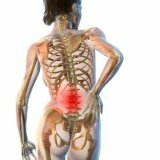Pinched sciatic nerve: causes, symptoms, treatment, how to quickly relieve pain
In this article, we will share the main principles treating inflammation, pinching of the sciatic nerve in adults, and also tell you about the first symptoms and causes of this condition.
Content
- What is a sciatic nerve entrapment?
- Causes
- Symptoms of a pinched sciatic nerve
- When should you see a doctor?
- Diagnostics
- How is a pinched sciatic nerve treated?
- What can help relieve sciatica pain instantly?
- Sciatica treatment at home
- Recipes for rubbing with sciatica
- Baths for pinching the sciatic nerve
- Compresses
- Folk pain relievers for oral administration
- Course and prognosis
- Prognosis for surgery
- Prevention and recommendations
What is a sciatic nerve entrapment?
A pinched sciatic nerve, commonly known as sciatica or sciatica, is severe pain felt along one of the two sciatic nerves.
Located at the back of each leg, these are the largest nerves in the body. (see diagram below). They connect the spine to the lower back, at the level of the lumbosacral spine (just above the tailbone).

The pain is mostly striking buttocks
and hips, and often extends to the area of the foot. Most often, pain only affects one side of the body.Pain from a pinched sciatic nerve can come on suddenly — for example, when you bend over or lift something heavy.
Causes
A pinched sciatic nerve is not a disease. This is a sign sciatic nerve inflammation. In most cases, this is due to herniated disc, which caused inflammation of one or another sciatic nerve root.
Symptoms vary slightly depending on the root affected. (The root is the part of the nerve that connects the spinal cord to the inside of the spine.)
Also, the following factors can be the cause of inflammation of the sciatic nerve:
- Narrow lumbar canal (spinal stenosis). Narrowing of the canal where the nerves enter can pinch the nerve root in the lumbar vertebrae and cause sciatica. This occurs mainly in the elderly.
- Piriformis syndrome. The reason is muscle inflammation a pelvis called the piriformis (piriformis) or pyramidal muscle. If this muscle is compressed and inflamed, it puts stress on the sciatic nerve and irritates it. Athletes and people who do not exercise properly are at risk.
- Facet syndrome. This syndrome occurs in the facet joints, the thin joints located at the top and bottom of each vertebra (not to be confused with intervertebral discs, another structure that allows you to connect vertebrae). Poor posture or improper movement can lead to slight displacement of the joints, which can lead to sciatica and back pain.
- Injury. A fall, car accident, or any other situation that causes a blow to the back can damage the nerve roots.
- Other reasons. Osteoarthritis or metastases that put pressure on the sciatic nerve can cause back pain and, less commonly, sciatica. Both of these situations occur mainly in the elderly.
Most people with sciatic nerve neuralgia symptoms resolve within 4 weeks. However, they often recur unless steps are taken to prevent it. Sciatica can also be associated with chronic low back pain.
This is not a complete list of all the reasons, but there is one more theory, which is interesting enough and has a right to exist. Its essence is as follows:
The tone of the piriformis, gluteal and dorsal muscles, they can just cause pain in the limbs and back, are not controlled by the person himself. We can easily strain them, but not relax them, giving this function to the brain stem. It has been noticed that positive emotions relax all muscles, while negative ones lead the muscles to tension.
Read also:Concussion
Remember your condition when a large dog barks near you. The whole body is on alert. And although you see that the dog is behind the fence, and it cannot reach you, it is not easy to relax immediately. Your body continues to be in good shape.
This condition can provoke in a person who has sciatica of the lumbosacral spine, pinched nerve, including the sciatic.
It is up to everyone to agree with this theory or not, but neuropathologists have noticed that a person who takes control of his emotions, all other things being equal, does not get sciatica.
Symptoms of a pinched sciatic nerve
The sciatic nerve departs from the lumbar spine, then stretches along the entire leg right up to the fingers, branching out and innervating all muscle groups of the lower limb. Sciatica, and sciatica, with pinched nerve fibers, causes the same pain that will start from the lower back and go down to the toes.
Often, pain in the sciatic nerve region is exacerbated by coughing, sneezing, or pressure.
When the disease is just beginning, the pain can be mild, but it gradually builds up and becomes simply unbearable, when a person cannot: sleep normally, walk and even sit.

Most often, attacks of pain syndrome begin after severe physical or psychological stress, as well as after hypothermia of the body.
The pain usually comes at night, but not necessarily.
The main symptoms are:
- severe pain, which the patients themselves describe as sharp, burning, cutting. Very often they appear suddenly and just disappear;
- violation of the sensitivity of the skin over the nerve passing under it. It can manifest itself both in the form of goose bumps, light tingling, and in the form of numbness (an optional symptom);
- manifestations of vegetative disorders are possible - sweating of the foot, the appearance of edema, redness of the skin;
- during the next attack, the patient tries to transfer weight to the healthy leg, relieving stress. This is manifested in a violation of a person's gait;
- the functioning of the sciatic nerve is disrupted and, as a result, the muscles of the leg. This manifests itself in a change in the size of the muscle - gluteal, femoral or gastrocnemius, the process of flexion and extension of the fingers of the lower extremity is disrupted.
When should you see a doctor?
When the first signs of sciatica appear, it is better to consult a neurologist (neuropathologist) for an accurate diagnosis.
If sciatic nerve entrapment is diagnosed and treatment does not help relieve pain or it gets worse, see your doctor again.
An urgent need to contact a neurologist if:
- the back pain is so severe that it is unbearable;
- sciatica symptoms are accompanied by incontinence or feces (or, conversely, delay), impotence, loss of sensitivity in the perineum and inside the thighs, or difficulty standing, climbing stairs;
- in addition to the main symptoms of sciatica, rapid and unexplained weight loss occurs.
Diagnostics
The diagnosis begins with simple questions from the patient:
- when and at what point did back pain occur (for example, when lifting a heavy object);
- where exactly it hurts;
- whether the pain spreads to the hips, buttocks;
- whether there is bladder or bowel incontinence;
- whether you have had back problems, sciatica, or a herniated disc in the past.
During the subsequent physical examination, the doctor checks, among other things, sensitivity, motor skills, and reflexes.
To correctly determine how to treat a pinched sciatic nerve, the doctor needs to find out the cause. For this, further research is usually used. This is especially necessary if there is a suspicion of a herniated disc.
Suitable diagnostic methods are, for example:
- radiograph;
- computed tomography and magnetic resonance imaging (CT and MRI);
- ultrasound examination;
- blood tests;
- analysis of cerebrospinal fluid;
- further neurological examinations.
Read also:Peripheral neuropathy
How is a pinched sciatic nerve treated?
After the diagnosis is made, the neurologist will prescribe a treatment for you, consisting of the following procedures:
-
Physiotherapy. It can help reduce or eliminate pain symptoms, but it does not treat the underlying cause, but treats the symptoms. From physiotherapy procedures, it is prescribed:
- Laser therapy;
- Electrophoresis;
- Magnetic or UHF therapy.
- Massage and reflexology. At the moment the pain subsides, acupressure and cupping massages, acupuncture, general massage, relaxing the back muscles are effective.
- Taking anti-inflammatory and analgesic drugs. But all drugs from this group also have side effects - irritation of the mucous membrane digestive tract, blood clotting decreases, there is a negative effect on work kidneys. Therefore, the course is taken only for a limited period and under the supervision of a physician.
- Physiotherapy.
- Sanatorium or mud therapy. It is carried out only during the period of remission.
What can help relieve sciatica pain instantly?
To quickly relieve pain associated with a pinched sciatic nerve, you can take pain relievers and non-steroidal anti-inflammatory drugs, for example:
- Ibuprofen;
- Diclofenac;
- Naproxen;
- Paracetamol.
It is best to talk to your doctor. He may also inject you pain medication directly into your back muscle, or he may prescribe a stronger pain medication.
In addition to pain management, depending on the cause, bed rest, rest, and warmth may be helpful in the acute phase of a pinched sciatic nerve.
In the short term, the doctor may also administer anti-inflammatory drugs (corticosteroids) and / or local anesthetics near the sciatic nerve root to relieve acute unbearable pain.

This treatment can relieve the pain associated with sciatica for several weeks. However, side effects such as bleeding, infections, and nerve damage can also occur.
Sciatica treatment at home
Sciatica can also be treated at home, after consulting a specialist.
Using folk remedies, there will be no negative consequences that appear after taking medications. However, before using it, it is worth confirming the diagnosis.
In folk medicine, various herbal decoctions are used for oral administration, compresses, rubbing and baths. Natural preparations work no worse than pharmacy ones, and there are much fewer side effects.
Recipes for rubbing with sciatica
Various herbal infusions are used to relieve severe pain when a nerve is pinched. They just need to be rubbed into the skin, but do not expect an immediate effect, the substances contained in the herbs must accumulate in your body to take effect.
When preparing tinctures for grinding, remember that you need to insist in a place inaccessible to sunlight.
- Take 2 tbsp. tablespoons of white lilac and pour over 300 ml of vodka. Insist warm for a week, strain and can be used for treatment. Rub in the resulting tincture before bedtime, it will reduce pain.
- Infusion of bay leaves. Pour 20 medium bay leaves with a glass of vodka and leave for 3 days. The resulting solution will help to significantly reduce pain.
- Mix freshly squeezed black radish juice with honey, observing the proportion: 3 to 1, before going to bed, massage into the sore spot until it is absorbed.
Baths for pinching the sciatic nerve
Warm baths with a decoction of plants have a beneficial effect. True, not everyone can soak up the water. Discard this method if you have:
- cardiac pathology;
- varicose veins.
- Method 1. Pass 100 grams of fresh horseradish through a meat grinder or grate, put the resulting gruel in a canvas bag and immerse in water at room temperature. Take the bath for no more than 10 minutes.
- Method 2. Take a kilo of fresh coniferous shoots, pour boiling water over them in a volume of 3 liters and put them on the stove, boil for another 10-15 minutes and leave to cool for 3-4 hours. Add to the bath with warm water at the rate of 1 liter of broth per 15 liters of water in the bathroom. Take water treatment for no more than 15 minutes.
Read also:Chorea of Huntington: what is this disease, symptoms, videos of patients, causes and treatment of this disease
Compresses
Compresses are also effective during the therapy of pinched sciatic nerve. They not only reduce pain, but also increase your mobility. For greater effect, it is better to cover the product with a plastic bag and a woolen scarf.
- Beeswax is often used in folk medicine, it will help here too. It needs to be flooded in a water bath, make a small cake, then apply to the place of pain. Leave it overnight.
- Cabbage leaves. Scald a few large cabbage leaves and apply them to the affected area. They need to be changed every 2 hours.
- Honey, a universal remedy, will also help with infringement. Heat a tablespoon of the bee product in a "water bath", then mix with 1 tbsp. flour. From the resulting mass, make a cake, you need to attach it to the sore spot. The pain will disappear in half an hour.
Folk painkillers means for oral administration
Not only does topical use help relieve pain. Treatment is faster and more effective if combined with ingestion of decoctions. One of the best remedies is a decoction of aspen leaves.
Fill in 1 tbsp. spoon a glass of boiling water and cook for 10 minutes, then let cool. You need to take the broth in the morning, at lunchtime and in the evening, 50 grams.
It will help in the treatment of sciatic nerve diseases and a decoction of calendula flowers. In 400 g of boiling water, pour 2 tbsp. spoons and cook for about 6 minutes, leave to brew for 2 hours and drink 0.5 cups before meals.
Horse chestnut is used in the manufacture of various warming ointments, but herbalists recommend additionally taking a decoction inside.
To prepare it, pour 2 teaspoons of powder from dried seeds with half a liter of boiling water, put the mixture in a water bath for 4 hours, strain and drink 100 grams before meals.
Course and prognosis
When the sciatic nerve is pinched, as a rule, the prognosis is favorable: the pain may disappear after a few days, a maximum of 6 weeks. Even if the pinched sciatic nerve is associated with a herniated disc, the pain may subside without treatment.
In general, for the further course of sciatica, it is usually important to strengthen the muscles of the back and not injure the back (for example, not to fall, not to lift something heavy). Moderate physiotherapy exercises are recommended.
Prognosis for surgery
The prognosis after surgery depends on the degree of sciatic nerve damage and certain factors. The prognosis can be favorable if:
- victims are younger than 35 years old;
- the time interval between sciatica and surgery is short;
- herniated disc with obvious neurological disorders.
Prevention and recommendations
A healthy lifestyle is recommended if you want to prevent pinching of the sciatic nerve. Therefore, we recommend that you follow the tips below:
- strengthen your back muscles, this will not allow pinching to occur - do gymnastics;
- keep your back in the correct position, both sitting and standing;
- do not strain yourself, carrying weights, the spine will thank you for this;
- do not overcool and strengthen the immune system;
- refrain from wearing high heels;
- and, of course, as little stress and strain as possible.
In order to control pain in the long term, it is important to regularly move and strengthen your back muscles.



